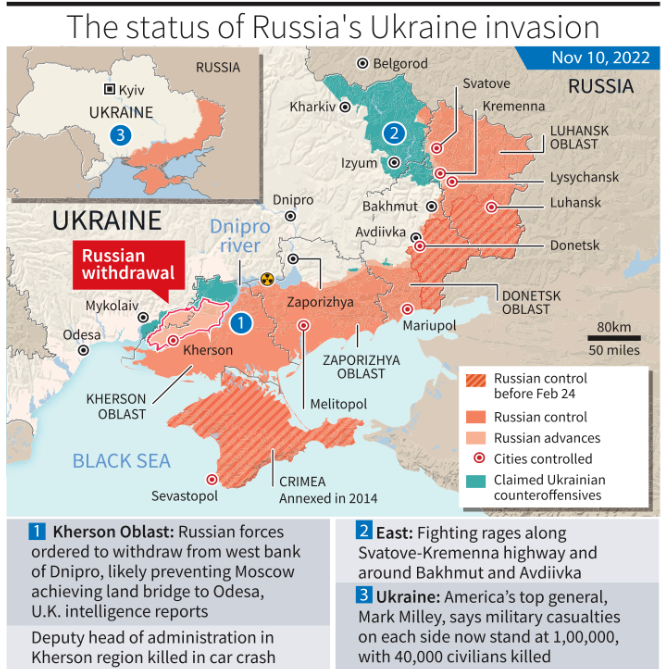Context:
Ukraine’s defence and intelligence unit has reported on the withdrawal of Russian troops from Kherson but predicts it to be a delusion for a retreat.

Relevance:
GS II: International Relations
Dimensions of the Article:
- Where is Kherson and why is it important?
- How did Kherson come under Russia’s control?
- Why has Moscow announced its withdrawal from Kherson?
Where is Kherson and why is it important?
- Geographically, Kherson is a strategic location for Russia and Ukraine.
- It is situated in the northwest of the Dnipro River, the province shares borders with Donetsk, Crimea and the Black Sea.
- With Moscow capturing Crimea in 2014, the occupation of Kherson in March 2022 has benefited Russia in transferring its military from Crimea to counter Ukraine.
- It provides access to Odesa and Black Sea ports in the west and serves as the main route to secure southern Ukraine.
- For Ukraine, regaining Kherson is significant to protect its population in Kalanchak and Chaplynka districts and also to recapture Crimea.
- Kherson is also an important region for its agricultural produce, with irrigation channels.
How did Kherson come under Russia’s control?
- In early March 2022, Kherson was captured by Russia through intense fighting.
- The battle of Kherson proved to be the starting point to capturing and occupying the southern part of Ukraine while the battles for Kharkiv and Kyiv in the north progressed.
- Russia’s hold over Kherson since March 2022 enabled Moscow to capture the key port cities — Mariupol in the Sea Azov, and Odesa, thus expanding control.
- Kherson’s irrigation canals were used as defence positions, creating a strong line preventing Ukraine’s counter-attacks. Russia also had positioned its soldiers in Kherson and stockpiled the ammunition.
Why has Moscow announced its withdrawal from Kherson?
The mobilisation failure:
- When Russia was advancing rapidly in capturing the southern and northern cities of Ukraine, its military personnel and weapon systems started to run thin.
- Russia then pursued a partial mobilisation as the next strategy to circumvent its on-ground limitations.
- The failure of new recruits added an additional challenge to Russia to keep its hold against the Ukraine counter-offensive in Kherson.
The inability of Russia to govern Kherson:
- Despite imposing martial law, Russia could not effectively rule Kherson; the three-level security in the occupied areas could not enforce Russia’s control on the ground.
Ukraine’s expanding counter-offensive:
- Until August, Ukraine was supplied only with short-range and low-grade weapons by the West.
- Later, Ukrainian soldiers received military training; as Moscow continued its onslaught, the West upgraded its support with medium to high-range weapons systems such as the Howitzers, HIMARS, air defence systems, battle tanks and drone technologies.
- It came from the U.S., the U.K. and Germany, whereas Russia’s procurement was slow and limited to Shahed drones. This helped Ukraine recapture Russian-occupied areas including Izyum, northeast, southeast of Kharkiv, Izyum-Slovyansk, Kupiansk in Eastern Ukraine, and northwest Kherson in the south.
- On the other hand, Russia has been facing challenges in augmenting its military hardware on the battleground.
-Source: The Hindu



